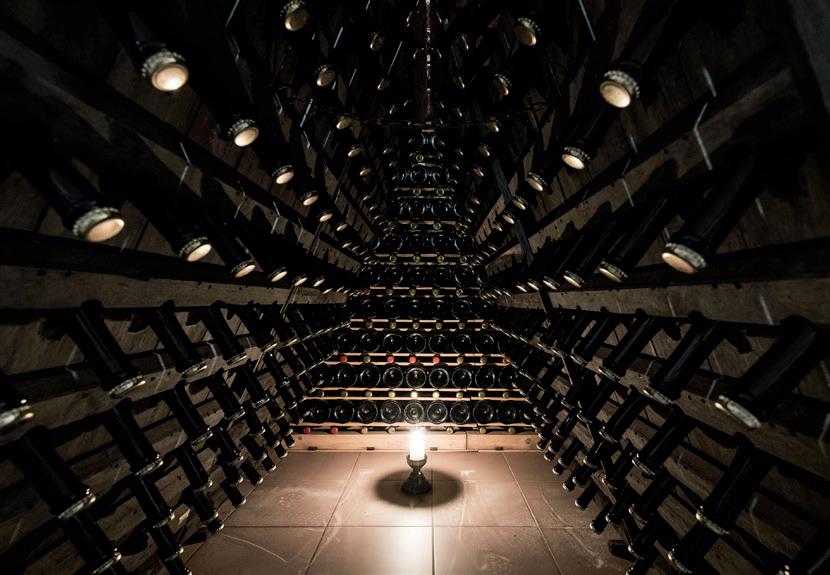
5 minute read
A glass of bubbly
The area of Eppan is dominated by wine-growing, and the production of sparkling wines also has a long tradition. Let's go on a bubbly tour of the three producers of sparkling wine.
Pearls are precious, enhancing the beauty of anything they touch. The bubbly pearls in a glass of sparkling wine are evanescent, but reflect the pleasure awaiting the connoisseur. The rulers – chiefly Austrian noblemen – of the many manorial estates of Eppan understood this. The first "Upper Adige Gold Champagne" was served up in 1902.
Advertisement
A blue-label countess "This is the cradle of South Tyrolean sparkling wine," explains Lorenz Martini of Girlan with a note of reverence in his voice. His father once put up a couple hundred bottles of sparkling wine for his own consumption. "And I was fascinated," remembers the son. But he wanted more. So in 1985, he began producing his own sparkling wine in an old cellar. Today, the Lorenz Martini Sparkling Wine Cellars produce 15,000 to 20,000 bottles of sparkling wine per year. The Comitissa Pas Dosé Riserva bears a noble name and an elegant blue label. "Comitissa" is the Latin word for "countess." "Pas Dosé" refers to its extreme dryness and minimal residual sugar (1.5 grams per liter) and the lack of added sugar. Martini has developed his own recipe for the proportions of Chardonnay, Pinot Blanc, and Pinot Noir.
A bunker for the Praeclarus sparkling wines In contrast, the St. Pauls Winery relies entirely on Chardonnay grapes. "We have been making sparkling wine since 1979," reports Dieter Haas, the head of operations. At present, production amount to 35,000 bottles a year. The Praeclarus Brut, a "sparkling wine for everyone," has recently been rejuvenated by reducing the amount of time it is matured in the bottle. It is allowed a minimum of 30 months on the lees before being freed of sediment ("disgorgement" – a procedure in which the plug of yeast is carefully removed) and the bottle filled up. The place where the bottles are stored is special – that's because the St. Pauls Winery stores its bubbly treasure in a bunker. At the Paulser Field not far from the village, the prominent, dome-like building dating back to the year 1937 is the resting place of six to seven vintages. The meter-thick walls ensure a constant temperature and moisture.
The Praeclarus sparkling wines of the St. Pauls cellars are literally bunkered. This is an ideal form of storage, and the facilities are open for tours in the summertime; group tours are possible, by appointment.


Produced according to the classic Champagne method (i.e., fermentation in the bottle), every sparkling wine made in Eppan is unique. The most-recent wine is allowed to rest on the lees for a whole 60 months. "With the Praeclarus Pas Dosé, we've partnered a vintage sparkling wine with our Brut," says Haas. It is a sparkling wine par excellence for which only select wines of a special year are used. The current one is from 2014.
A new beginning with the "Lamm N° 12" The "Lamm N° 12" is presented in a thick-bellied bottle and a flower-decorated box. It is made by Winkler Sparkling Wine in Girlan – named after the family residence in the Lammweg 12. "We emphasize wine-making as a craft. The entire process of making sparkling wine – from the vineyards to the fermentation stage and so on – is based on manual labor. Ours is a family-run business, and it's going to stay that way," states the proprietor, Michael Winkler. He individually turns the bottles on the riddling racks from the Champagne region by hand. After 20 years of stagnation, he revived the production of sparkling wines. Founded in 1977 by his father, Helmuth Winkler, operations had to cease in 2001 for health reasons. On March 29, 2021, the eldest son finally presented a fresh, eminently drinkable sparkling wine – produced using the Champagne method, using Chardonnay (70%), Pinot Noir (20%), and Pinot Blanc (10%), extra brut with 3 g/l of residual sugar. The grapes for the annual production of 13,000 bottles come from parcels at an altitude of 550 meters above sea-level. "A high acidity and phenological maturity are important for our style," explains Winkler. The elegant presentation is a component of the overall effect contributing to this 2022 rosé.

A family with a passion for distilled spirits


At the 2020 World Gin Awards in London, the St. Urban distillery won the award for "Best Italian Classic Gin."
Water, malt, meticulous care, and passion: You can taste them all in the St. Urban Single Malt. To select the fi nest raw materials from their own estate and use them to obtain the best-possible fi nal product – that is what drives this father and son team. Th ey are always striving for the highest quality. In the retail shop at their estate, one fi nds traditional distilled spirits such as grappa, fruit and berry brandies, liqueurs, and other fi ne alcoholic products. But they also carry special items with such fl avors as cacao bean, blood orange, and gin. At the 2020 World Gin Awards in London, their gin was recognized as the "Best Italian Classic Gin." Th eir latest creation is the St. Urban Single Malt. Th is malt is characterized by moderate smokey notes, a mild malty sweetness, and wonderful fruit aromas which the whiskey develops aft er maturation in Gewurztraminer-Passito barrels.

Business hours of the retail store: Monday-Friday: 10 a.m. – 6 p.m. | Saturday: 10 a.m. – 4 p.m. Tastings, by arrangement.
St. Urban distillery Lammweg 13 39057 Girlan | Eppan Phone: +39 338 502 72 26 Phone: +39 339 121 13 28 www.st-urban.it










